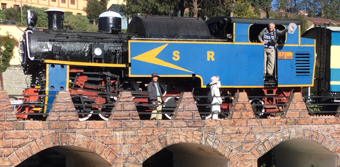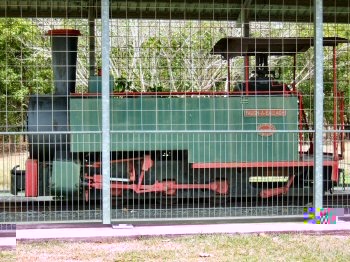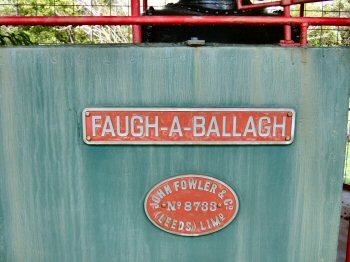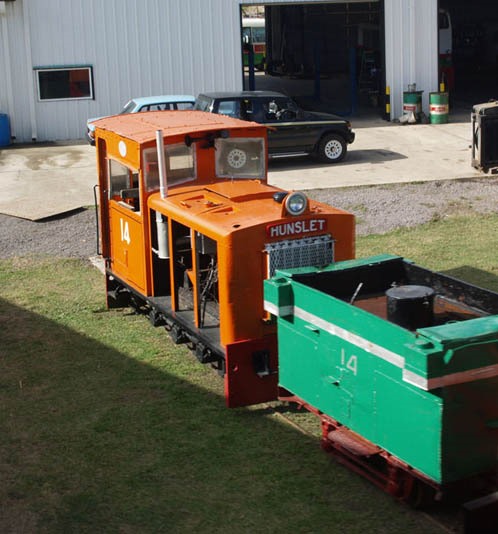Memoirs of a Trainspotter-
by John Swash
| |
The Railway Children
My introduction
to trainspotting was during the school summer holidays in 1960
at the end of my first year at West Leeds school.
A few friends who lived near me in Bramley invited me along on
a day out trainspotting.
We set off on foot from Bramley on a tour of locomotive depots
or "sheds" as we called them. Our first stop was Farnley
Junction shed at the top of a long hill. Then we walked along
a footpath past Copley Hill sidings and loco shed and over a very
long metal footbridge to Holbeck, one of the main sheds in Leeds.
If we had enough time, we would climb up a wall and an embankment
to reach a spot known as the "magic triangle". This
area was a patch of railway land located at the centre of a triangle
of tracks. From there, we could spot almost every train coming
out of both Leeds Central and City stations. Even today, the Holbeck
triangle of railway viaducts between Water Lane, Globe Road, and
Springwell Road still exists in part and has a memorial to a railwayman
who was killed while working there. From Holbeck it was only a
short walk to Central Station for more trainspotting and we could
take the train back to Bramley.
|
I was obviously
hooked on trainspotting because I asked my mother to buy me Ian
Allen's Combined Volume of BR Locomotives for Xmas that year in
which I could record the numbers of locos I had spotted simply
by underlining them in the lists the book contained.
Ian Allen also published shed guides which gave the location of
all UK locomotive depots and directions for getting to them. In
the next couple of years accompanied by my pals, I travelled further
afield by train during school holidays on trainspotting day trips.
We visited several places, including
Doncaster station and locomotive works where I saw the prototype
"Deltic" loco in its blue and yellow striped livery
speeding nonstop through the station. The return fare to Donny
was 3/6d .We also went to York station, shed, and railway museum,
and travelled by the Trans Pennine train to Manchester Victoria
and Exchange stations, which had the longest platform in the UK
at the time. We caught a bus to Altrincham to visit sheds at Trafford
Park and then went to Piccadilly station, which was the terminus
of the overhead electrified Woodhead line from Manchester to Sheffield.
This was my first sight of electric mainline locos, and we took
one of the electric-hauled trains for a short trip. We visited
Longsight shed and also went to Belle Vue Zoo in the afternoon.
It wasn't
long before we all had road bikes and would cycle long distances
to railway destinations as far away as York & Skipton, in
addition to all the loco sheds in Leeds. York shed with its two
large roundhouses is now the National Railway Museum. I have a
good memory of a day out in York, on my own, in summer 1961. I
decided to combine train spotting with sightseeing. I went to
the roof of York minster and from the tallest tower had a superb
view over the city. The river and the rail lines curving into
the station were gleaming in the sun and to top it all an express
train hauled by a streamlined Gresley A4 Pacific loco, glided
around the curve of shining rails as it entered the station. If
only I had owned a camera with a telephoto lens! On another trip
to York, we found two "Streaks " on shed and cabbed
them both. i.e. climbed onto the footplate. One of them had a
corridor tender to enable the driver and fireman to be relieved
on non-stop express services.
The locomotive works at Doncaster and York manufactured new locomotives.
Local engine sheds each had a number, Holbeck was 55A I remember.
A number of locomotives would be allocated to each shed. Each
loco carried its shed number on a small plate. After a few visits,
you would have collected all these local locos but the shed also
serviced visiting locos from other sheds so there was generally
something new to see. One loco we regularly spotted was a Jubilee
Class loco "Bihar & Orissa" which we nicknamed "Boris
& 'Orris".
I didn't take up photography until
I bought a 35 mm camera in my late teens so the only photographs
I took in my early trainspotting days were these two at Holbeck
with a box Brownie camera circa 1961.
|

Ian Allan's Combined Volume - the trainspotter's bible, cost
11/6 in 1963.
The cover Photo is an streamlined A4 Pacific Locomotive , designed
by Nigel Gresley. We called these locomotives "Streaks"
|
 Jubilee
Class No 45584 "North West Frontier" Jubilee
Class No 45584 "North West Frontier"
|

A1 Class No 60134 "Foxhunter"
|

Leeds -Holbeck, shed no. plate.
|
When I say we "visited" a loco
shed I don't mean an authorised official visit. We just used to
turn up to the shed, walk in through the gates and then wander
around the sites collecting numbers. Sometimes a friendly railway
worker would give us the nod or at other times a foreman might
yell at us to clear off. At larger establishments such as York
or Doncaster Works, if we were lucky, we could occasionally just
tag onto the back of an official party of visitors and no one
noticed.
Trainspotting at major stations was possible for the price of
a penny platform ticket. You would usually find a small group
of spotters at the end of the longest platform where you could
observe all trains entering or leaving the station. Leeds Central
station was one of my favourite spots. Named express trains such
as the" White Rose "and the "Yorkshire Pullman"
terminated there. These London express trains were often pulled
by mainline locos stabled at LNER's "Top Shed " at Kings
Cross. Trains from London would have a few coaches which would
carry on to Bradford, very often hauled by a Jubilee Class loco,
on the line which ran through the cutting bordering the school.
Leeds Central station was a terminus railway
station in Leeds for over 100 years. The last train left from
Leeds Central on 29 April 1967. It was an early evening service
to Harrogate filled by the usual Birmingham RC&W DMU. Detonators
were placed on the track by railway staff which exploded as the
train rolled away from the platform and past the signal box on
its final departure. After closure, part of the station site became
a Royal Mail sorting office. Some of the station fittings were
preserved at the NRM in York. including the cast iron railings
and gate to the platforms where you showed your ticket. There
was also a blackboard with a chalk message about the final train
to leave the station.
In the early 1960s, I would spend a couple of weeks in the summer
holidays visiting relatives who lived in Romford, Essex. My uncle
worked in planning for BR at Stratford and my aunt had worked
at Liverpool Street station where she occasionally did the station
announcements. This gave me the chance to train spot in London.
I vividly remember seeing 70000 "Britannia" for the
first time thundering through Romford station.
Trainspotting had a vocabulary all of its own. I still remember
much of it today probably better than the German irregular verbs
I was learning at about the same time.
If you were a trainspotter these terms might mean something to
you:
|
"Streak" - universal
nickname, for the Nigel Gresley Class A4 Pacific locos of which
Mallard is the best-known example.
"German Blinkers" - German-style smoke deflectors
"Light engine" - a loco not hauling wagons or
coaches
"Double Header" - train hauled by 2 locos
"Banker" - train assisted by a 2nd loco at the
back often used on steep gradients.
"Boris & 'Orris" - Nickname for Jubilee class
loco "Bihar & Orissa" often seen on-shed at Leeds.
"Co-Co and Bo-Bo"
- not clowns but wheel arrangements for the bogies of diesel locomotives.
|
The Railway Club
Interest in trains was probably helped
by the fact that the school had a railway running along the fence
in a cutting between us and the girls' school. At break some of
us would make a beeline to see the Leeds - Bradford train which
was often pulled by a Jubilee Class Loco and frequently passed
the school during our morning break. These trains also passed
my home further along the line in Bramley. I was in my 3rd year
at WLHS before I became aware that the school had a railway club
which held meetings after school in the history room. The teacher
in charge was Jim Morgan but my fellow 3rd former Ian Copley was
the leading light and organiser. These group trips, mostly by
coach, were properly organised with official permission to enter
the railway sites.
Brian Palmer remembered the formation of the club. In
1956 or so, there was a club of trainspotters. A group of them
invited me to accompany them to Doncaster one Saturday to collect
"namers". Their parents would only agree if a member
of staff was involved. Old collector in my youth, I said yes and
we had a successful day, even paying an illegal visit to the 'sheds'
to collect more names. All impossible nowadays, I guess.
In the mid-1960's the railway club organised a number of trainspotting
trips all over the country during half-term holidays. On these
trips we witnessed the passing of the steam era. Early trips were
to locomotive works and "sheds" full of steam engines,
by 1965 we were visiting scrapyards in Barry, South Wales.
On the Midlands and South Wales trip in 1965 we visited 18 locomotive
depots ("sheds") and works, 4 scrapyards in South Wales
and 2 docks in the space of about 3 days. The trip organisers
were Ian Copley and David Cavill and two teachers who often went
along were Jim Morgan and Tony Norcliffe. Another trip in 63 or
64 took us up the East Coast main line to Newcastle and Edinburgh,
then across to Glasgow and back down the West Coast mainline.
For some reason (train delayed or cancelled) we all spent the
third night in the waiting room of Carlisle station playing a
card game called Cheat in front of a roaring fire with a snowstorm
raging outside. Whenever we heard the rumble of a passing train
someone was delegated to go out onto the platform to get the number
of the loco, preferably without letting in too much of a blast
of cold air and snow flurry to discomfort the rest of us. Anyone
who has read A Day in the Life of Ivan Denisovitch will appreciate
the dilemma. (In the Gulags outside work for prisoners was compulsory
until the temperature reached -50C. One unlucky prisoner was deputed
to go outside and check the thermometer without breathing on it
or letting cold air into the hut.)
|
The day the Merchant Navy came to Leeds.
In 1964 Southern Region Merchant Navy class
loco no.35012, named "United States Lines", visited
Holbeck shed en route to head a special train up to Settle and
Carlisle the next day. I heard about it on the grapevine and hundreds
of us flocked to Hobeck shed that evening for a rare sighting
of a SR mainline loco in Leeds! I cycled there after school. One
reason that evening is etched in my memory is that I should have
been revising for my Maths O level exam the following day.
Amazingly, I found this photo online almost
60 years after the event. I remember there was some discussion
among the railwaymen whether this engine could use the Holbeck
turntable owing to size or weight restrictions.
BR Southern Region
loco no.35012 "United States Lines" at Holbeck shed
in 1964.
|
 |
|
Once a trainspotter always a trainspotter?
I have no idea what the attraction of
trainspotting was. I'll only make two observations : First it's
a boy's thing-, I never saw Jenny Agutter or any other girl among
the gaggle of trainspotters on any station platform that I visited
and secondly boys seem to be compulsive collectors, be it cigarette
cards, football cards , stamps etc. At least collecting train
numbers was harmless unlike collecting birds' eggs or butterflies.
With some collectors it's a lifelong passion but others grow out
of it.
My own interest in trains waned immediately
after leaving school which coincided with the end of the steam
era on BR. I was definitely a BR Green and Carmine Red livery
fan and was much less interested in the succeeding BR Blue period
and the later privatisation. I had less interest in diesels and
none in DMUs and EMUs. (Diesel and electrical Multiple Units)
with the possible exception of Deltic mainline locos, named after
the Greek letter Delta shape of their Napier engines. At the time
Deltics were the world's most powerful diesel locomotive, and
introduced the first 100mph diesel passenger train service to
the UK. They regularly ran at higher speeds and were clocked at
125mph descending Stoke Bank.
Mike Collins, an old boy who worked as a civil engineer on the
railways in the 1960s and got up close and dirty with both steam
and diesel, made the following comments: please do not associate
me romantically with railway locomotives in any way. My early
sort (steam) were just damned nuisances when I was stuck in the
middle of a tunnel, and unable to make my way out because of the
lack of any visibility, and the later diesels, combined with weekend
excavators, again in tunnels, are believed to have caused my 24-year-old
chest disease, from which I was expected to die in 1990! So, no
love there, either!
Richard Craven commented: I enjoyed reading your trainspotting
piece. brought back some good memories. I regularly did the 55c
56c and 55a tour on my bike. Many trips to Donny (3/6 return)
and York. I only went on one Railway Club trip, to the Manchester
sheds, Newton Heath and a few others. It was one winter evening,
late '62 or early '63 I remember there was a heck of a lot of
snow and the trip back to Leeds was quite hairy.
|
|
"There is a corner of a foreign field
that will always be a part of Hunslet ".
In retirement, my interest in railways has rekindled
somewhat. I enjoy visiting railway museums and preserved railways
at home and abroad. I like train travel particularly abroad. I
have often visited Switzerland, which has a marvellous railway
system, and have travelled on both the Glacier and Bernina Express
trains. My last train trip of note was on the Nilgiris Mountain
Railway in Tamil Nadu, Southern India. I must admit that finding
an old loco in far-flung parts of the world always raises my spirits
and when you read the manufacturer's nameplate it's amazing how
many were made in Leeds by the Hunslet Engine Co. or John Fowler
when we really were the workshop of the world.
|
The Nilgiri Mountain Railway (NMR) is a metre gauge railway in
Nilgiris district, Tamil Nadu, India, built by the British in
1908. The railway is operated by the Southern Railway and is the
only rack railway in India.
The author "cabbing" an X class loco No. 37386 at Ooti
station on the Nilgiri Mountain Railway. ( rt)
|
  |
 |
 |

|
|
I found this little, Leeds built, tank engine in Port Douglas,
Australia, retired after a working life in the sugar cane fields
in Northern Queensland.
|
"Faugh-a-Ballagh" is an Irish battle cry meaning
"Clear the way". It is the motto of the Royal Irish Fusiliers |
A Hunslet diesel engine I came across in the sugar cane
fields of St. Kitts. |
|
Tale from BR Fireman working the down Yorkshire Pullman
As a Fireman in 1959 I worked this job a few
times. First stop Doncaster where the Steward from the train would
bring us up a Pot of Coffee. Next stop Wakefield, where the Steward
would come and collect his Pot. Next stop Leeds where we got relieved,
straight into the station buffet for a couple of pints to wash the
coal dust from our mouths. It's then up the road to the Chippie
for our fish & chip supper, we'd eat that as we walked to Farnley
Depot where our lodge was, a hostel slap bang in the middle of the
depot triangle, for a nights sleep. The up side of those couple
of pints we had back at the station was that they'd help us sleep
through the clanking of steam engines running around the triangle
all night! Next morning, following a breakfast of whatever we'd
brought with us, no catering staff there, we'd walk to Copley Hill
depot to pick up our engine from the previous day and work another
express from Leeds to London. There you go, two days (plus around
9 tons of coal) in the life of a Fireman at Top Shed in the Summer
of 1959. The two engines that covered that job that Summer were
60103 (Flying Scotsman) and 60062 (Minoru), both Class A3 locos.
I am surprised that
the footplate crew walked from Central station to their hostel in
Farnley at the end of a long hard working day. As a young train
spotter aged about 12- 14 I often used to walk from Bramley to Farnley
shed, then on to Copley Hill and Holbeck shed and Central station
before getting the bus back home, but I hadn't shovelled 5 tons
of coal and finished an 8 hr shift before the walk.
For the benefit of non-train spotters "Top Shed" was the
main BR Eastern Region shed at Kings Cross, and loco No 60103 was
Flying Scotsman.
This
is a short video of Top Shed in 1959.
|
|